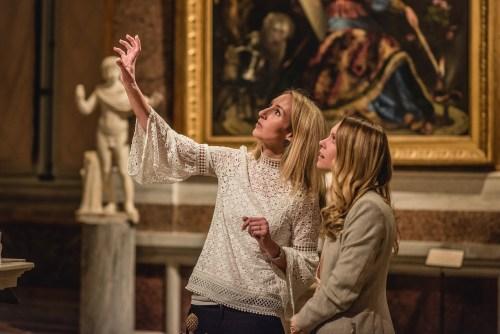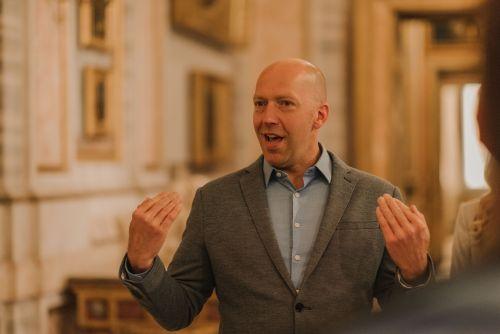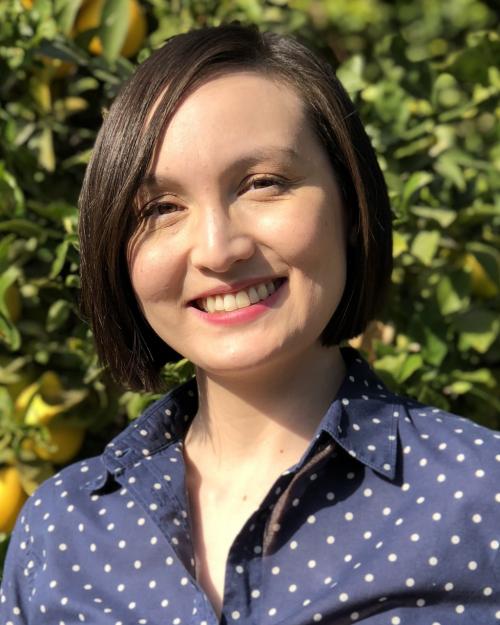
Blog
Alumni Profiles Series: Meagan Green Labunski and Matthew Woodworth
Dr. Meagan Green Labunski is the CEO and Co-Founder of Curated Touring, a small group travel company based in Austin, Texas. In 2010 she received her Ph.D. in art history from Duke, where she specialized in medieval Italian architecture. Since graduation, Meagan has completed postdoctoral research supported by the Gladys Krieble Delmas Foundation and taught at Texas A&M University and Baylor University.
Dr. Matthew Woodworth, CFO and Co-Founder of Curated Touring, received his Ph.D. in art history from Duke in 2011. His dissertation, “The Architectural History of Beverley Minster, 721-c. 1370,” was the first focused study on the English Gothic church. Matt has taught at the University of Aberdeen and Duke, as well as co-written two volumes in the Buildings of Scotland series published by Yale University Press.
Art, Art History, & Visual Studies alumni Dr. Meagan Green Labunski and Dr. Matthew Woodworth joined forces in 2018 to start Curated Touring, a luxury touring company specializing in small-group travel to destinations throughout Europe. Featured in Lonely Planet, Forbes, Departures, and Town and Country, Curated Touring provides guests with intimate experiences of history through an art historical lens. Their trademark is privileged, behind-the-scenes access to museums and buildings that only their academic credentials can unlock. On their latest trip to Rome, Matt and Meagan guided guests through the art and music of the ancient city alongside the Miró Quartet, who played for guests in a private, after-hours opening of the Galleria Borghese—the first live performance at the venue in over 200 years. I caught up with these art historian-entrepreneurs at their offices in Austin, Texas to talk about graduate school at Duke, life after academia, and starting a business.

WHAT WERE YOUR CAREER PLANS DURING GRADUATE SCHOOL? WERE YOU BOTH ON THE TEACHING TRACK?
ML Absolutely. I love teaching! But as much as I loved surveys and seminars, I really missed being in the places that had pulled me into that material in the first place. Getting back to teaching on site was really appealing to me. It was exciting to think about moving beyond the classroom and reaching a different audience—and getting to share the material in a different way.
MW It was exactly the same for me. This company allows us to do what we’d been doing all along, but to spend our time taking people to the actual places that we love. It’s about a really authentic interaction, an authentic experience, a human experience rather than just sitting in a classroom.
WHERE DID THE IDEA FOR CURATED TOURING COME FROM?
MW When you’re an art historian, you spend a lot of time abroad during your Ph.D. We would go to Europe and see group tours come through led by the person holding an umbrella and reciting Wikipedia. For a lot of people, visiting these sites should have been fun and exciting, but they’re stuck on these uninspirational tours just ticking off the boxes. They’re not learning anything. That’s what we’re countering. Meagan and I had been talking about these tour groups, how they could be magical but were falling so short, and after about five years we just decided to do it. You’ve got to have the nerve.
ML Exactly. We felt like our experiences and expertise could offer a new lens for travelers wanting a deeper dive into European art and culture.
MW We just thought if we don’t do it now…
ML …we would always wonder. It was a big leap of faith.
DID YOUR GRADUATE TRAINING PREPARE YOU FOR STARTING YOUR OWN BUSINESS?
ML One of the things that we laugh a lot about is that as business owners we’ve had to wear so many new hats. Even though our particular graduate school and previous academic experiences didn’t specifically train us for tasks like designing a website or creating a marketing campaign, the perseverance and determination required to successfully complete a Ph.D. program have been critical for this journey. The ability to see a project to fruition has been really important for both of us.
MW Perseverance in the face of doing something that you’ve never done before. I remember the first time I gave a conference paper, the first time I wrote a seminar paper, the first time I wrote a dissertation—everything that you do in graduate school is the first time that you’re doing it. It’s really important to have that ability to face something completely new and say, “I’m going to figure out how to do this,” even if you make some mistakes along the way. I feel like all the things that we learn in graduate school—how to communicate, how to write effectively, how to make an argument, proficiency in foreign languages—are all skills that set us up for Curated Touring.
HOW DOES YOUR PROFESSIONAL EXPERIENCE IN THE ACADEMY HELP WITH RUNNING CURATED TOURING?
ML First off, many of the experiences we are able to offer, like closing churches or shutting down museums for private viewings, can only happen because of our academic credentials. Secondly, we set up each tour like an informal class. We move through the material chronologically because we want people to easily make connections between the sites and works that they experience at the beginning of the week and at the end. The material builds. At the end of the tour, guests can look back and see how the narrative has played out. Nobody [else in the business] organizes their itineraries chronologically because it’s a logistical nightmare! But it’s worth the extra effort because you can see those lightbulbs go off. Especially for places as complex as Rome, where people really walk away understanding that sweep of history. And that’s exciting for us.
MW It’s fantastic when you go chronologically through Rome. You start with Romulus and Remus, then you talk about the Forum, and then you do the Emperors. When you get to the Renaissance and you talk about the Vatican—how the popes in the 16th century said that their goal was to become the new emperors of Rome—people can really understand that. It’s not an abstract concept. They think back to all those temples we saw on day one and realize that this is what the papacy wants the Sistine Chapel to be. Everything comes full circle.
WHAT ARE YOUR FAVORITE PARTS OF RUNNING CURATED TOURING?
ML Curated Touring allows us to do what we love the most—being on site and communicating the messages of the art and architecture to people who are really excited to be there. Our guests are so eager for meaningful interactions with these histories, these stories, and these places. When guests say, “I’ve been to Rome five times but you’ve lit a spark for me. I’ve loved seeing it in a new way; I can’t wait to come back,” that’s really exciting and gratifying for us. And it’s an honor to get to show people these places and spaces that we love.
MW Actually being in those spaces—the museums, the buildings, the cities—is a real privilege. When you teach art history at the college level, you lecture on cathedrals in a dark classroom with photographs. You tell students, “When you actually go to Chartres, the effect of the stained glass is magical, but it’s impossible to photograph,” and they have to take you at your word. Getting to see it in real life is magical. Taking people through these places, in the actual buildings themselves, allows you so much freedom because you’re all there experiencing it together.
ML From an intellectual perspective, I’ve loved being able to more deeply explore some of the material I’ve always been interested in--but never had the opportunity to teach an in-depth course on--as well dive into works and artists who have piqued a new interest for me. It’s been fun to see how our interests have evolved.
MW It’s been great to offer a service in which we have this expertise. People are interested in the buildings, paintings, and sculpture, so when you speak to an intelligent audience and make it come alive in a way that they can understand, it’s wonderful. It’s been great to take all our art historical training and bring it to an audience that’s so receptive. You can tell people are hungry for it because as soon as people finish a tour, they’re already signing up for the next one.

WHAT ADVICE CAN YOU GIVE CURRENT GRADUATE STUDENTS?
MW I think no matter what program people are in, there is a way to use the skills you learn in graduate school beyond being an academic. Especially for people in the humanities, there really is life after academia. There are so many wonderful skills that you learn in graduate school that are marketable in other areas. If you don’t want to go the teaching route, or if you go the teaching route and decide it’s not for you, there are so many viable ways of creating things—really enjoying yourself and doing something that’s valuable. There are lots of people who will be interested in what you know, and you just need to broaden your scope and think about how to put yourself out there. It’s been really fun for us, and I think you just need to have the chutzpah to do it. You have to take the risk.
ML Precisely. And don’t underestimate the research and writing skills you are developing. They are invaluable for any field.
WHAT IS ONE OF YOUR FAVORITE MEMORIES OF DUKE?
MW When I taught at Duke, one of my favorite lectures was taking students around Duke Chapel. I specialize in English Gothic architecture, so it was fun to have that time warp between 7 centuries—talking about how the Chapel looks like a real medieval building, how it doesn’t, what the architect got right, what he got wrong, whether the stained glass matched what we had seen in class, what a medieval person would have thought if they walked into the Chapel.
ML Early on I took the Methodology of Art History seminar with Dr. Kristine Stiles. We met in the evening, and after almost every class we went to The Federal and all had burgers together, sometimes a glass of wine, and we continued class discussions in a casual, informal way. I really appreciated that she made time for that kind of extracurricular conversation to continue.
Author

Nicole Y. Gaglia
Ph.D. candidate, Art History
Nicole Y. Gaglia is a sixth-year Ph.D. candidate in the Department of Art, Art History & Visual Studies and 2019-20 Graduate School Administrative Intern. Her work focuses on modern Japanese art and visual culture. Her dissertation, "Visualizing Bodies: Public Health and the Medicalized Everyday in Modern Japan,” examines images to ask how visuality shaped public discourses on health, the body, and sociality in modern Japan.